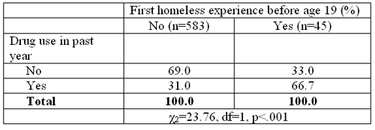Research shows higher lifetime and six month prevalence of substance use disorders among the homeless than found among non-homeless populations (Fischer, Shapiro, Breakey, Anthony, & Kramer, 1986; Koegel, Burnam, & Farr, 1988). The social adaptation model (Stark, 1987) suggests that homelessness might be a risk factor for substance use. This week’s STASH reviews a study that examines the relationship between homelessness and substance use.
Using a multistage probability design, trained interviewers from the University of Illinois at Chicago Survey Research Laboratory surveyed English speaking adults between the ages of 18 and 40 living in the city of Chicago between June 2001 and January 2002 (Johnson & Fendrich, 2007). Participants (n=627, response rate = 40%) reported their lifetime and most recent substance use (i.e., tobacco, alcohol, marijuana, cocaine, crack, heroin, hallucinogens, inhalants, stimulants, tranquilizers, sedatives, and pain relievers), frequency and age of onset of substance use, and onset and recency of homelessness. Researchers used bivariate and multivariate statistics to analyze the association between early homelessness (i.e., before age 19) and recent substance use.
Figure. Association between First Homeless Experience and Recent Drug Use . Adapted from (Johnson and Fendrich, 2007). Click image to enlarge.
Analysis revealed that 66.7% of
participants who had experienced homelessness prior to 19 years of age (n=45)
also had used substances within the past year. In comparison, only 31% of those lacking early homeless experiences
(n=583) reported substance use within the past year (χ2=23.76, df=1,
p<.001; cf. Table 1). Multivariate
analyses, controlling for the age of first substance use, also yielded a
significant link between early homelessness and recent substance use
(unstandardized coefficient=0.23, standard error=0.08, p<0.01).This study
has several limitations. First,
self-report often results in participants underestimating their socially
undesirable behaviors (e.g., substance use, homelessness). Second, as a result of the low response rate
(40%) and exclusion of currently homeless people, the participants might not
accurately represent the Chicago homeless population.
Third, other
factors known to be related to homelessness (e.g., childhood abuse and history
of mental illness; Koegel, Melamid, &
Burnam, 1995),
were not measured; without accounting for these risk factors, the study cannot
measure the independent effect of early homelessness on substance use.
Despite the limitations, this study
does indicate an association between homelessness and substance use. Perhaps homeless people start using drugs to
better deal with their daily struggles on the street or they might be
introduced to drugs within homeless shelters. Alternatively, excessive substance use might lead to financial ruin or
involvement in other illegal activities, resulting in homelessness. Whatever the reasons for the association
between drug use and homelessness, findings from this study suggest that public
health interventions should include efforts to address both the potential for
homelessness among drug users and the potential for drug use among homeless
people.
What do you think? Please use the comment link below to provide feedback on this article.
References
Fischer, P. J., Shapiro, S., Breakey, W. R., Anthony, J. C., & Kramer, M. (1986). Mental health and social characteristics of the homeless: a survey of mission users. American Journal of Public Health, 76, 519-524.
Johnson, T. P., & Fendrich, M. (2007). Homelessness and Drug Use: Evidence from a community sample. American Journal of Preventative Medicine, 32(6S), S211-S218.
Koegel, P., Burnam, A., & Farr, R. K. (1988). The prevalence of specific psychiatric disorders among homeless individuals in the inner city of Los Angeles. Archives of General Psychiatry, 45, 1085-1092.
Koegel, P., Melamid, E., & Burnam, A. (1995). Childhood risk factors for homelessness among homeless adults. American Journal of Public Health, 85, 1642-1649.
Stark, L. (1987). A century of alcohol and homelessness: demographics and stereotypes. Alcohol Health and Research World, 11, 8-13.





